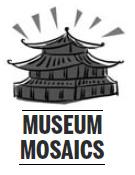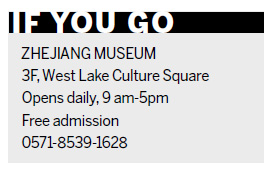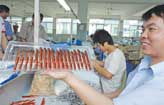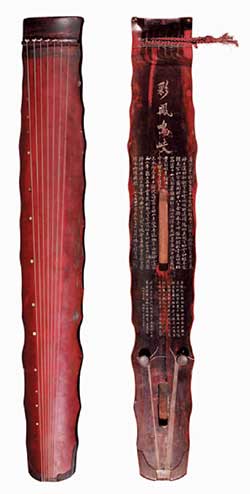Heritage
Strings from another age
Updated: 2011-07-10 07:49
By Zhang Kun (China Daily)
|
Cai Feng Ming Qi now rests at the Zhejiang Museum. Provided to China Daily |

Thousands of years ago, the Chinese were already making music with zithers, an instrument much loved by scholars, musicians and even martial artists. Zhang Kun looks at a priceless legacy.
The instrument sold for 115 million yuan ($23.2 million) at a Beijing auction two months ago. Yet an auction expert still felt it was undervalued. The 1,200-year-old guqin Da Sheng Yi Yin (大圣遗音) or "musical legacy of the sage", was made by the Lei family workshop in the Tang Dynasty (618-907 AD).
Liu Yue, manager of the ceramics and crafts department of China Guardian Auctions, which sold the instrument, said the price was actually low considering the instrument is probably the only guqin from that era still available on the market today.
Why is a simple string instrument so highly valued?
The answers may be found at the Zhejiang Provincial Museum, which has one of China's best collections of the seven-stringed zither. In the Zhejiang collection, the most famous is an instrument named Cai Feng Ming Qi (彩凤鸣岐) which translates to "cock phoenix singing on Mount Qi".
The guqin has a history of more than 3,000 years and it was favored by the Chinese literati as an instrument of great subtlety and refinement. Sometimes referred to as the choice of the sages, it is often associated with Confucius. The great instruments were conferred names, in honor of their excellence.
Cai Feng is one of a pair of Tang Dynasty instruments made by the Lei family studio. The other is Lai Huang (来凰), its feminine phoenix partner.
According to Yang Zongji, a scholar and guqin musician who lived from 1863 to 1933, Cai Feng was the work of Lei Wei, the master of the workshop. It was one of 50 instruments in Yang's collection. After Yang died, his guqin collection was sold, and Xu Fu bought about half of it. Xu was an official of the old Kuomintang regime, and when he left for Taiwan in 1949, his family in Zhejiang sold his collection of instruments to the museum.
Yang had recorded that Cai Feng was kept at the Imperial Palace, and was part of the dowry of a royal family member. The instrument was later lost when the Eight Nations Alliance invaded and looted Beijing in 1900 during the Boxer Rebellion, before it was recovered by Yang.
"This is partly why this guqin is particularly valuable," says Fan Peiling, a researcher with Zhejiang Museum. "Its legendary background tells a lot about China's history."
More importantly, the instrument is in fine condition, and Yang had described it thus: "It gives off the sound of bronze bells and stone chimes, rather than silk strings."
In 2008, the Zhejiang Museum invited three respected guqin musician - Cheng Gongliang, Ding Chengyun and Yao Gongbai - to record an album with the twin instruments, Cai Feng and Lai Huang. The musicians were impressed with Cai Feng, describing its tone as "mellow and gentle".
Cai Feng is 124.5 centimeters long and 18.8 centimeters at its widest, and it has stayed in almost perfect condition for the past 1,000 years. And Yang Zongji wrote a long poem about its history and had it carved on its underside, right beneath the four characters "Cai Feng Ming Qi".
"Wood will change as it ages. Sometimes it develops a purple patina on top of the original golden brown," says Ni Shiyun, a guqin player and craftsman for 35 years. "The sound will change subtly as the guqin ages, getting more and more beautiful through the years. Like good Chinese liquor, the fragrance gets mellower after centuries.
"Traditional guqin had silk strings, and now we use nylon or steel strings to produce the louder sound that modern concert halls require. In ancient times, guqin recitals were limited to intimate gatherings of three to five," says Ni.
"The best way to protect an instrument is to keep playing it," Fan says. That is why the Zhejiang museum often organizes concerts, like the one last year when it invited 14 musicians from home and abroad to play on Cai Feng and Lai Huang.
The museum is also proposing a new project in which musicians can take the instruments out on loan to perform.
"A famous guqin of great value will add to the charm of a concert, and good musicians will help to keep the instruments in good condition."
You can contact the writer at
zhangkun@chinadaily.com.cn.


Specials

90th anniversary of the CPC
The Party has been leading the country and people to prosperity.

The write stuff
'Pen capital' goes back to drawing board for answers to economic changes taking shape in Zhejiang

Say hello to hi panda
An unusual panda is the rising star in Europe's fashion circles
